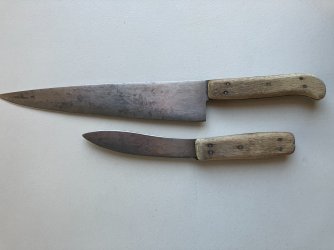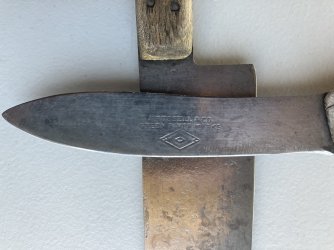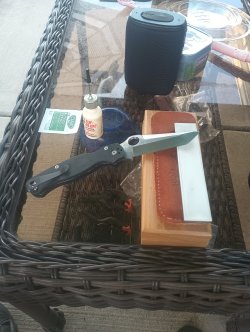I hand my dull knives to my eldest grandson. He does a bang-up job and like Bluto said: "it don't cost nothing".
You are using an out of date browser. It may not display this or other websites correctly.
You should upgrade or use an alternative browser.
You should upgrade or use an alternative browser.
Knife sharpening
- Thread starter F4phantom
- Start date
I have a large knife collection. Some are collectors (mint pre-1990 Case folders) some more modern (Emerson. Benchmade, Spyderco, Cold Steel, Busse, Kellam, Ahti, Marttiini, Roselli). Blade shape sort of determines the optimal sharpening method. However for a beginner I would avoid anyththat is powered. It is too easy to do too much and do more harm than good. A cheap but very good sharpening system is the lowly crock sticks. A wood block with 2 or 4 angled holes and 2 or 4 round ceramic rods. You only need to hold the knife with the blade vertical and let just the edge slide down the rod while moving down and back at the same time. Sounds complicated but it is simple. YouTube has videos. A set of crock stick is cheap and very effective. Just make sure the rods are generally straight and have no defects. In general the grey rids are rougher and the white ones are smoother. I will use a little bit of adhesive paper label to make sure the kids if snug in the base. As metal builds up on the rod rotate it a slight amount. The rods can be cleaned with stove top cleaner and rinsed under water. Ebay can be a good source for some crock sticks (under $20). The longer ones are easier to use. Good luck.
DRankin
Member
Made me smile.I have several old (circa 1980's) Gerber knives..........
I use these in the kitchen everyday.


As near as I can tell the skinner was made prior to about 1875 because that's when J. Russsell/Green River Works changed from a stamped logo to one acid etched. The kitchen knife is not marked but shows the same handle materials, rivets and age.
They were discovered together when an old pioneer house was being demolished in northern rural Nevada.
Last edited:
I can't sharpen a knife if my life depends on it.
Neighbor is retired and loves to sharpen stuff.
Works out well, I get sharp knives, he gets bourbon.
Neighbor is retired and loves to sharpen stuff.
Works out well, I get sharp knives, he gets bourbon.
- Joined
- Jan 8, 2005
- Messages
- 2,534
- Reaction score
- 14,764
I have been using the Lansky system for about 40 years. They will replace any damaged stones and actually sent me a new box when I told them the original red one warped over time.
I have used and own a number of stones, but I rely on the Lansky for my kitchen knives.
I machined my own 'stand' to place in my vice so I don't have to hang on to the knife/clamp assembly during sharpening. Works nicely as it pivots when needed for blade lengths.
I transitioned my original stone system to add some diamond cutters. Medium and fine only. The original course stones cut some of the work in half when needed.
bdGreen




I have used and own a number of stones, but I rely on the Lansky for my kitchen knives.
I machined my own 'stand' to place in my vice so I don't have to hang on to the knife/clamp assembly during sharpening. Works nicely as it pivots when needed for blade lengths.
I transitioned my original stone system to add some diamond cutters. Medium and fine only. The original course stones cut some of the work in half when needed.
bdGreen




Porcelain plates and metal pans are real edge destroyers. Bone and coarse hair ain't the best on them either.
My wife and step daughters can wreck an edge quick. I have an old carbon steel butcher knife in the rack I use a lot. It stays sharp because it is ugly and they don't use it. LOL
My wife and step daughters can wreck an edge quick. I have an old carbon steel butcher knife in the rack I use a lot. It stays sharp because it is ugly and they don't use it. LOL
The most important thing I learned about sharpening is to sharpen one side until a burr forms along the edge, then switch to the other side and sharpen until you get a burr. At that point the two sides have come together in the sharpest edge possible. Then strop off the burr.
Another thing that helped me was to use coarser stones to start with. If I start with too fine a grit I get frustrated or bored and start varying the angle. Unless the blade is pretty sharp to begin with, I start with a diamond stone, then progress to medium and fine.
I use a Spyderco Sharpmaker with the diamond rods. The only angle you need to maintain is 90 degrees, which is easy to recognize and keep. After I get a burr with the coarse rods I use the medium until I get a burr and then usually go to the fine rods and get a burr. Then strop off the burr.
For cutting meat and other fibrous material like rope, a medium grit cuts better than a fine grit. For carving wood, use a fine grain to finish.
Another thing that helped me was to use coarser stones to start with. If I start with too fine a grit I get frustrated or bored and start varying the angle. Unless the blade is pretty sharp to begin with, I start with a diamond stone, then progress to medium and fine.
I use a Spyderco Sharpmaker with the diamond rods. The only angle you need to maintain is 90 degrees, which is easy to recognize and keep. After I get a burr with the coarse rods I use the medium until I get a burr and then usually go to the fine rods and get a burr. Then strop off the burr.
For cutting meat and other fibrous material like rope, a medium grit cuts better than a fine grit. For carving wood, use a fine grain to finish.
Hence the skilled use of a steel which seems to elude a lot of people.One thing that I've learned is it's easier to touch up a knife than it is to do a full sharpening on one
- Joined
- Apr 4, 2006
- Messages
- 19,796
- Reaction score
- 31,638
I have been sharpening knives ever since I was about 10 years old. In the beginning I took a dull knife and made it even duller using a silicone carbide stone - or similar! lol! After I got married 46 years ago I bought a Lansky (or similar) system. Years later I bought the KME system which IMHO is way better, gave me great results but took way too long for each knife and replacement stones are costly. I then bought the Spyderco system and while it works well, it is basically only good for slightly dull knives. Start with a really dull knife and you will be there all day long! Along the way, (about 38 years ago) I purchased a really good set of 3 Arkansas Stones. Again, they can give great results if you have the muscle memory to hold a consistent angle, but take a while if doing multiple knives. They are also a bit more messy as I used them with honing oil.
A few years ago I decided to get serious about sharpening and I needed a method to sharpen knives fast and at the same time be able to make them razor sharp if I want to (depending on what knife I am sharpening). At the urging of StrawHat here on the forum, I bought a bunch of larger diamond stones (3" x 8" and 3" x 10") in different grits. Since buying them I have done many hundreds of knives, scissors, chisels, etc and they are IMO the absolute best way to go. The diamond stones last a very long time too! Someone doing sharpening just on their own personal knives will probably get decades out of quality diamond stones. A 325 - 350 grit and a 1200 grit are the two (course an fine) stones I'd get. Finishing the process with a good leather strop and that is all you will need IMO.
Learning to hold a consistent angle is way more important that the actual degree of angle you sharpen to. Anywheres around 15º-20º is good and 17º is what I sort of shoot for but never really check. For fine cutting knives I will lean towards the 15º and for your average knife about 17-18º. If the knife is a shop knife subject to rough work, I will even increase the angle a bit more to 22º - 25º, but again, I no longer measure the exact angle - I just go by feel now. The key is develop muscle memory to hold the angle consistent. There is no magic bullet other than to keep practicing, use your thumb and forefinger as an angle guide, and use a magnifying lens to make sure you are getting one consistent angle instead of many different facets.
I can usually sharpen a dull kitchen knife in about 7-10 minutes (including stropping). One that has been really abused and neglected and needs re-profiling obviously will take me longer - about 15 minutes. I know many can do it faster, but probably not better. When I sharpen a knife, I sharpen it to what it will be used for.
I know some buy the Worksharp products (a bit pricey to buy and get belts and parts for) but I personally do not like using a glorified motorized belt sander on fine knives. Sometimes I will use a belt sander to rough profile a knife that is in really poor shape and needs to be thinned a little. I then finish by hand on the diamond stones. Yes it can be quicker but most who use them exclusively more than likely cut the longevity of the knife down by removing too much metal each time it gets sharpened. On my own personal knives I never let them get really dull and I can put a razor sharp edge back on them in 30 - 45 seconds just with the diamond stone. A few licks on the strop and the sharpened knife is back in the block in a minute. Hand sharpening is a developed skill that many can do if they are determined. Some just want the easy way out. Whatever method or sharpening system you use needs to satisfy your needs, skill level, pocketbook and patience level. BTW, a diamond stone needs no real maintenance, requires no electricity, oil or water so it can be used anywhere.
A few years ago I decided to get serious about sharpening and I needed a method to sharpen knives fast and at the same time be able to make them razor sharp if I want to (depending on what knife I am sharpening). At the urging of StrawHat here on the forum, I bought a bunch of larger diamond stones (3" x 8" and 3" x 10") in different grits. Since buying them I have done many hundreds of knives, scissors, chisels, etc and they are IMO the absolute best way to go. The diamond stones last a very long time too! Someone doing sharpening just on their own personal knives will probably get decades out of quality diamond stones. A 325 - 350 grit and a 1200 grit are the two (course an fine) stones I'd get. Finishing the process with a good leather strop and that is all you will need IMO.
Learning to hold a consistent angle is way more important that the actual degree of angle you sharpen to. Anywheres around 15º-20º is good and 17º is what I sort of shoot for but never really check. For fine cutting knives I will lean towards the 15º and for your average knife about 17-18º. If the knife is a shop knife subject to rough work, I will even increase the angle a bit more to 22º - 25º, but again, I no longer measure the exact angle - I just go by feel now. The key is develop muscle memory to hold the angle consistent. There is no magic bullet other than to keep practicing, use your thumb and forefinger as an angle guide, and use a magnifying lens to make sure you are getting one consistent angle instead of many different facets.
I can usually sharpen a dull kitchen knife in about 7-10 minutes (including stropping). One that has been really abused and neglected and needs re-profiling obviously will take me longer - about 15 minutes. I know many can do it faster, but probably not better. When I sharpen a knife, I sharpen it to what it will be used for.
I know some buy the Worksharp products (a bit pricey to buy and get belts and parts for) but I personally do not like using a glorified motorized belt sander on fine knives. Sometimes I will use a belt sander to rough profile a knife that is in really poor shape and needs to be thinned a little. I then finish by hand on the diamond stones. Yes it can be quicker but most who use them exclusively more than likely cut the longevity of the knife down by removing too much metal each time it gets sharpened. On my own personal knives I never let them get really dull and I can put a razor sharp edge back on them in 30 - 45 seconds just with the diamond stone. A few licks on the strop and the sharpened knife is back in the block in a minute. Hand sharpening is a developed skill that many can do if they are determined. Some just want the easy way out. Whatever method or sharpening system you use needs to satisfy your needs, skill level, pocketbook and patience level. BTW, a diamond stone needs no real maintenance, requires no electricity, oil or water so it can be used anywhere.
DRankin
Member
Who makes the diamond stones you prefer?
Autonomous
Member
- Joined
- Feb 25, 2017
- Messages
- 1,157
- Reaction score
- 1,800
I bought a Spyderco Sharpmaker years ago as I needed something easily carried in my grip. It is not fast, but it gets the job done. Most of the diamonds have fallen off the sleeves but as I am only doing my own knives now, I don't need them anymore.
I finish with a leather strop.
I finish with a leather strop.
Last edited:
I have used a Lansky sharpener for years but probably not correctly. I start at the second highest angle with the medium diamond stone and then go to the medium stone when I can no longer see a reflection of a flat edge. I then go to the 30 degree angle with the medium stone for a few passes and finish up with the fine stone for a few passes. I'm sure this gives me a decent (not good) edge but is usually ok for me. I've never used the ultra fine stone.
I've never stroped my knife during or after sharpening to remove the burr. It would probably help if I did this but I'm not sure I would be able to maintain that extra sharp edge for long enough for it to make a longterm difference.
I never bother with keeping up with my wife's kitchen knives because her knives are used to cut porcelain plates and granite counter tops. Her edge doesn't last very long and so I wait until she makes a specific request which is made when the edge dulls to the same sharpness as the back of the blade. ;<}
BTW, my Benchmade folder with 154CM steel gets more effort than most of my other knives. I've had that knife for a number of years and it has served me well.
I've never stroped my knife during or after sharpening to remove the burr. It would probably help if I did this but I'm not sure I would be able to maintain that extra sharp edge for long enough for it to make a longterm difference.
I never bother with keeping up with my wife's kitchen knives because her knives are used to cut porcelain plates and granite counter tops. Her edge doesn't last very long and so I wait until she makes a specific request which is made when the edge dulls to the same sharpness as the back of the blade. ;<}
BTW, my Benchmade folder with 154CM steel gets more effort than most of my other knives. I've had that knife for a number of years and it has served me well.
Similar threads
- Replies
- 5
- Views
- 249
- Replies
- 59
- Views
- 2K
- Locked
Expired/Withdrawn
Gerber, Paul Series II Model 2 knife, LAST Price Drop
- Replies
- 0
- Views
- 598
- Replies
- 34
- Views
- 3K

